Related Research Articles
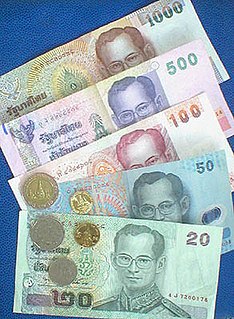
The baht is the official currency of Thailand. It is divided into 100 satang. The issuance of currency is the responsibility of the Bank of Thailand.

The forint is the currency of Hungary. It was formerly divided into 100 fillér, but fillér coins are no longer in circulation. The introduction of the forint on 1 August 1946 was a crucial step in the post-World War II stabilisation of the Hungarian economy, and the currency remained relatively stable until the 1980s. Transition to a market economy in the early 1990s adversely affected the value of the forint; inflation peaked at 35% in 1991. Since 2001, inflation is in single digits, and the forint has been declared fully convertible. As a member of the European Union, the long-term aim of the Hungarian government may be to replace the forint with the euro, but that does not appear to be likely until some time during the 2020s.

The lek is the official currency of Albania. It was formerly subdivided into 100 qindarka or qintars, but qindarka are no longer issued.
The Colombian peso is the currency of Colombia. Its ISO 4217 code is COP. The official peso symbol is $, with COL$ also being used to distinguish it from other peso- and dollar-denominated currencies.

The riel is the currency of Cambodia. There have been two distinct riel, the first issued between 1953 and May 1975. Between 1975 and 1980 the country had no monetary system. A second currency, also named "riel", has been issued since 20 March 1980.
The Congolese franc is the currency of the Democratic Republic of the Congo. It is subdivided into 100 centimes.

The Djiboutian franc is the currency of Djibouti. Its ISO 4217 currency code is DJF. Historically, it was subdivided into 100 centimes.
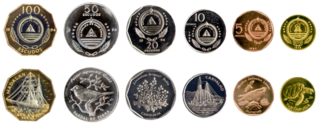
The escudo is the currency of the Republic of Cape Verde.
The peso was the currency of Paraguay between 1856 and 1944. It replaced the real at a rate of 8 reales = 1 peso. Until 1870, the peso was subdivided into 8 reales. Paraguay then decimalized, with 100 centésimos = 1 peso. The name of the subdivision was changed to centavo in 1874. The peso was replaced in 1944 by the guaraní at a rate of one hundred to one.
The Malayan dollar was the currency of the British colonies and protectorates in Malaya and Brunei until 1953. It was introduced in 1939, replacing the Straits dollar at par, with 1 dollar = two shillings four pence sterling.
The Thailand one-satang coin is a currency unit equivalent to one-hundredth of a Thai baht. It is rare in circulation but used in banking transactions.
The Thailand five-satang coin is a unit of currency equivalent to one-twentieth of a Thai baht. It was introduced in 1908 as a coin with a hole through its middle, which was minted until 1939. In 1946 the hole was removed and the new Thai monarch featured on the obverse: Rama IX. In 1996 a five-satang coin marked the 50th anniversary of his reign.
The Thailand twenty-five-satang coin is a currency unit equivalent to one-fourth of a Thai baht. It is commonly called salueng by Thai speakers. Salueng is the name of a historical Thai measurement, equal to one quarter of a baht or 3.75 grams (0.132 oz).

The Thailand fifty-satang coin is currency unit equivalent to one-half of a Thai baht. It is also called สองสลึง.
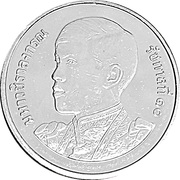
The one-baht coin is a denomination coin of the Thai baht, the Thai currency unit.
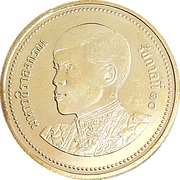
In Thailand, the two-baht coin is the coin which is worth 2 baht or 200 satang. The new 2-baht coin design features H.M. King Bhumibol Adulyadej, the Great on the obverse, like all other Thai legal tender coins presently in circulation. The reverse design depicts the Golden Mountain at Wat Saket Ratcha Wora Maha Wihan in Bangkok.

The Thailand five-baht coin is a denomination coin of the Thai baht, the Thai currency unit.
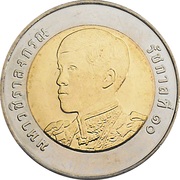
The bi-metallic Thailand ten-baht coin is a denomination coin of the Thai Baht, the currency unit of Thailand.
The franc was the currency of Réunion until 1999. Before 1975, Réunion had its own franc, distinct from that of France. After 1975, the French franc circulated. Réunion now uses the euro. The Réunion franc was subdivided into 100 centimes.
The history of Thai money used as a medium of exchange and to settle accounts before the adoption of Thai baht coins and banknotes include novel designs and forms. For Thai people, money was considered as the symbol of civilization. Currency itself reflected faith in religion, culture, the customs and traditions of each era and also serve as a record of the development of Thailand.
References
- ↑ Treasury Department e-catalog Archived 2011-10-06 at the Wayback Machine
- ↑ Treasury Department e-catalog Archived 2011-08-15 at the Wayback Machine
- ↑ http://worldcoingallery.com/countries/display.php?image=img11/175-37&desc=Thailand y37 10 Satang (1908-1939)&query=Thailand